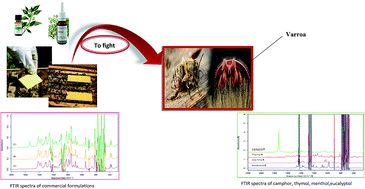当前位置:
X-MOL 学术
›
Anal. Methods
›
论文详情
Our official English website, www.x-mol.net, welcomes your feedback! (Note: you will need to create a separate account there.)
Fourier transform infrared analysis of commercial formulations for Varroa treatment
Analytical Methods ( IF 3.1 ) Pub Date : 2017-10-30 00:00:00 , DOI: 10.1039/c7ay02058a K. Bounaas 1, 2, 3, 4 , N. Bouzidi 1, 2, 3, 4 , Y. Daghbouche 1, 2, 3, 4, 5 , S. Garrigues 6, 7, 8, 9 , M. de la Guardia 6, 7, 8, 9 , M. El Hattab 1, 2, 3, 4
Analytical Methods ( IF 3.1 ) Pub Date : 2017-10-30 00:00:00 , DOI: 10.1039/c7ay02058a K. Bounaas 1, 2, 3, 4 , N. Bouzidi 1, 2, 3, 4 , Y. Daghbouche 1, 2, 3, 4, 5 , S. Garrigues 6, 7, 8, 9 , M. de la Guardia 6, 7, 8, 9 , M. El Hattab 1, 2, 3, 4
Affiliation

|
A comparative study has been carried out between univariate and multivariate calibration strategies for the simultaneous determination of camphor, thymol, menthol and eucalyptol in commercial formulations used for Varroa treatment. Absorbance peak heights of the transmission mid-infrared (MIR) spectra of individual monoterpenes, prepared in dichloromethane, were measured at 1737, 1151, 1022 and 980 cm−1 (corrected with a base-line at 1933 cm−1) for camphor, thymol, menthol and eucalyptol, respectively. Data were processed using the proportional equations approach in univariate mode. For multivariate calibration, partial least squares (PLS) regression based on a classical 42 design for standards was employed. It was used to obtain information from spectral ranges between 1812–1667 cm−1 and 1200–955 cm−1 to build PLS models using different spectral pre-processing techniques after mean centering of infrared data. The root mean square error of prediction (RMSEP) was considered to select the optimum model for each monoterpene. The accuracy of both assayed strategies was evaluated from samples spiked with different amounts of the four compounds. Recovery percentages from 91% to 98.7%, 105.5% to 116.9%, 95% to 108.2% and 100.1% to 107.1% were achieved for camphor, thymol, menthol and eucalyptol, respectively, by using PLS.
中文翻译:

用于Varroa处理的商业配方的傅里叶变换红外分析
在单变量和多变量校准策略之间进行了比较研究,用于同时测定用于Varroa治疗的商业配方中的樟脑,百里香酚,薄荷醇和桉树油。对于樟脑,在二氯甲烷中制备的单个单萜的透射中红外(MIR)光谱的吸光度峰高分别在1737、1151、1022和980 cm -1(用1933 cm -1的基线校正)下测量,百里香酚,薄荷醇和桉油酚。在单变量模式下使用比例方程方法处理数据。对于多元校准,基于经典4 2的偏最小二乘(PLS)回归采用标准设计。它用于从1812–1667 cm -1和1200–955 cm -1之间的光谱范围中获取信息,以在对红外数据进行平均居中后,使用不同的光谱预处理技术建立PLS模型。预测的均方根误差(RMSEP)被认为可以为每个单萜选择最佳模型。从掺有不同量的四种化合物的样品中评估了两种测定策略的准确性。通过使用PLS,樟脑,百里香酚,薄荷醇和桉树油的回收率分别从91%到98.7%,105.5%到116.9%,95%到108.2%和100.1%到107.1%。
更新日期:2017-11-17
中文翻译:

用于Varroa处理的商业配方的傅里叶变换红外分析
在单变量和多变量校准策略之间进行了比较研究,用于同时测定用于Varroa治疗的商业配方中的樟脑,百里香酚,薄荷醇和桉树油。对于樟脑,在二氯甲烷中制备的单个单萜的透射中红外(MIR)光谱的吸光度峰高分别在1737、1151、1022和980 cm -1(用1933 cm -1的基线校正)下测量,百里香酚,薄荷醇和桉油酚。在单变量模式下使用比例方程方法处理数据。对于多元校准,基于经典4 2的偏最小二乘(PLS)回归采用标准设计。它用于从1812–1667 cm -1和1200–955 cm -1之间的光谱范围中获取信息,以在对红外数据进行平均居中后,使用不同的光谱预处理技术建立PLS模型。预测的均方根误差(RMSEP)被认为可以为每个单萜选择最佳模型。从掺有不同量的四种化合物的样品中评估了两种测定策略的准确性。通过使用PLS,樟脑,百里香酚,薄荷醇和桉树油的回收率分别从91%到98.7%,105.5%到116.9%,95%到108.2%和100.1%到107.1%。


























 京公网安备 11010802027423号
京公网安备 11010802027423号